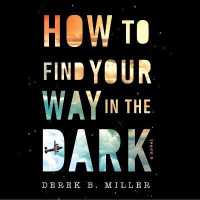Full Description
Often seen as supernatural, unpredictable, illusory and possibly dangerous, ESP, telepathy, clairvoyance and other parapsychological activities are actually happening all the time and help us make sense of everyday experiences. First Sight provides a new way of understanding such experiences and describes a way of thinking about the unconscious mind that makes it clear that these abilities are not rare and anomalous, but instead are used by all of us all the time, unconsciously and efficiently.
Drawing upon a broad array of studies in contemporary psychology, the author integrates a new model for understanding these unusual abilities with the best research in psychology on problems as diverse as memory, perception, personality, creativity and fear. In doing so, he illustrates how the field of parapsychology, which, historically, has been riddled with confusion, skepticism and false claims, can move from the edges of science to its center, where it will offer fascinating new knowledge about unmapped aspects of our nature. The author demonstrates that the new model accounts for accumulated findings very well, and explains previous mysteries, resolves apparent contradictions, and offers clear directions for further study. First Sight also ventures beyond the laboratory to explain such things as why apparent paranormal experiences are so rare, why they need not be feared, and how they can be more intentionally accessed. Further study of this theory is likely to lead to a "technology" of parapsychological processes while drastically revising our conception of the science of the mind toward a new science more humane and more replete with possibility than we have imagined in the past.
Contents
Preface
Section I: A Point of View
1: A New Conception Guided by Two Analogies
2: A Model and a Theory of Psi
Section II: Elaborations of the Model and the Theory
3: A Model of the Mind and of the Place of Psi in Mental Functioning
4: Psi and Consciousness
5: The Vicissitudes of the Extrasensory: To Be Known or Not to Be Known 59
6: Some Implicit Assumptions That Need to Be Changed
7: Psychokinesis: First Sight and First Act
8: Precursors of the Model
9: A Reiteration of Essential Points
Section III: Psi and Other Preconscious Processes
10: Psi and Ambiguous or Unconscious Sensory Information
11: Psi and Memory: Are the Processes Similar?
12: Psi and Memory: How Do They Affect One Another?
13: Psi and Creativity
Section IV: First Sight and Other Research Findings
14: Fear and Psi
15: Extraversion and Psi
16: Other Individual and Situational Factors
17: Two Vexing Problems: Experimenter Effects and Decline Effects
Section V: First Sight beyond the Laboratory
18: Ordinary Nonpsychic Experience
19: The More Psychic Person
20: First Sight and Personal Exploration of Psi
21: First Sight in the Consulting Room
Section VI: Prospects for Parapsychology
22: Recent Research Pertinent to First Sight
23: Applications of First Sight
24: Suggested Directions for Future Research
25: First Sight, Parapsychology, and Other Branches of Science
26: Psi and a New Science of the Mind
Acknowledgments
References
Index
About the Author






